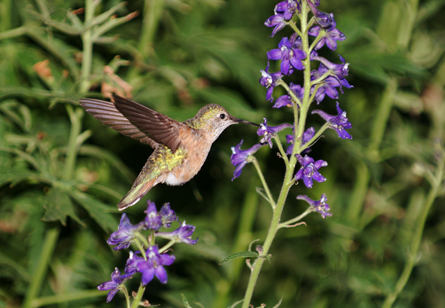Throughout the world, climate change is causing age-old ecological partners to miss their cues as seasons shift. The trend may be so strong at higher latitudes that researchers now propose that some species’ ranges could actually shrink away from the poles.

This idea comes from studying broad-tailed hummingbirds that migrate north from Central America each spring to high-altitude breeding sites in the western United States. With only brief mountain summers to raise chicks, male hummingbirds typically arrive in the region before the first flowers bloom and scout for territories.
Around the Rocky Mountain Biological Laboratory in Gothic, Colo., near the upper limit of the broad-tailed hummingbird breeding range, the gap between the first hummingbird arrival and the first bloom has narrowed by roughly 13 days during the last four decades. Amy McKinney of the University of Maryland in College Park and her colleagues report the discovery online May 14 in Ecology.
Glacier lilies start blooming roughly 17 days earlier than they did in the 1970s, but birds haven’t sped up nearly as much. In a few extreme years, lilies have already started blooming before the first hummingbird showed up. Researchers calculate that if the timing trends continue, in about two more decades the males will routinely miss the first flowers.
Other flowers do bloom throughout the summer, but losing the beginning of the flowering season cuts into an already tight breeding schedule. Around the Rocky Mountain laboratory, broad-tailed hummingbird pairs now have time to raise only one brood, with at most two chicks, per summer. And as far as timing goes, McKinney points out, “they’re already falling behind.”
If shifts in available flowers end up hampering efforts to raise chicks, then this northerly zone of current breeding territory may someday dwindle away.
Such timing mismatches are probably very common, says evolutionary ecologist Marcel Visser of the Netherlands Institute of Ecology in Wageningen. He has documented difficulties with the spring return of migratory European birds, called pied flycatchers, that have been left behind by earlier and earlier peaks of caterpillars that would once have fed the chicks.
Some broad-tailed hummingbirds that breed farther south have less of a problem, McKinney and her colleagues report. By pooling decades of data collected for various projects, the group compared timing on the north rim of the birds’ breeding range with almost 30 years of bloom and bird records at sites in Arizona. There’s no clear-cut narrowing of the gap between arriving males and the first blooms of an Indian paintbrush species that starts off the nectar season.
Climate change ecologist Anthony Richardson says he’s not yet convinced that higher latitudes on land really do see more dramatic changes in timing of biological events. And marine trends so far seem to lessen with increasing latitude, reports Richardson, of the University of Queensland in St. Lucia, Australia.
What’s needed now, says hummingbird study co-author David Inouye of the University of Maryland, is more data on timing of events in whole communities of creatures. As ranges change at different rates, he says, “I think we’ll see a lot of shuffling.”





